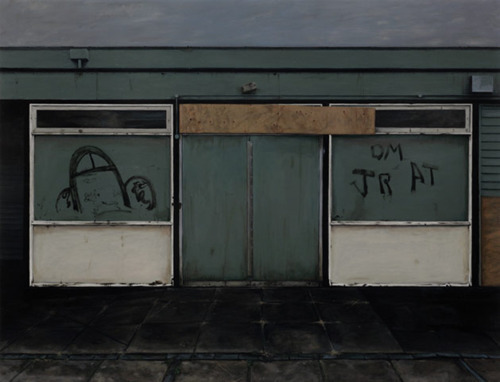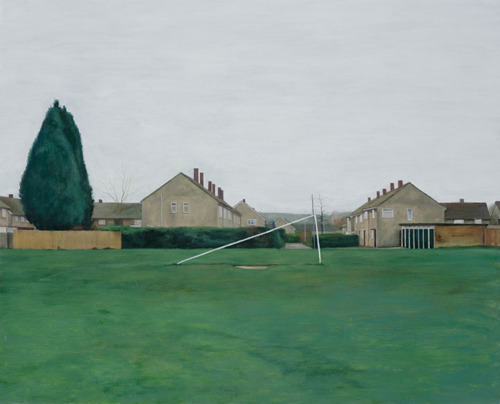Ash Wednesday: 8:30am, 2004/5
George Shaw’s Tile Hill paintings explore the daunting provisionality — and banality — of identity
“A Sly and Unseen Day,” at the Baltic Centre for Contemporary Art, Gateshead, England, Late Spring 2011
In an interview with journalist Gordon Burn, painter George Shaw explained that his Tile Hill series, precise and melancholic depictions of Tile Hill, the council estate in the Midlands of England where he grew up, was “allegorical for the present,” exploring “the relationship that banality has with, say, horror.” One of the four artists nominated for the 2011 Turner Prize, presented annually to a British visual artist under 50, Shaw combs through the place he grew up in the series, preserving places that have been destroyed, looking for something he’ll never find. He is caught in Tile Hill, and he is enjoying his imprisonment—a sentence we enjoy too, faced with the dizzying array of tiny moments and scenes, the forgotten alleyways and gunnels of a forgotten place, that make up the identity of one fully rounded person.
Shaw takes snapshots during his walks around Tile Hill, then creates a painting from the artless results. Tile Hill is not a pretty place. The cookie-cutter houses have small windows and small gardens; they’re full of brick, concrete paths and a stucco-like surface ingloriously called pebble-dash. The community center is run down. The pubs have burned to the ground.

The Back That Used to Be the Front depicts double doors flanked by shop windows, all of which have been painted over with a gray green. The transom above the doors is boarded up, initials and a phallic drawing brushed on the glass. We see the transitory nature of a public space’s vitality, the creeping disinterest of the community. Shaw suggests that this back alley means something—that it’s as relevant as the house he grew up in or the footprint of the burned-down pub where his father used to drink. This implies that anything, no matter how seemingly banal, might be the keystone of his identity.
Shaw described how Francis Bacon has written of “paint trying to trap reality.” But for Shaw, “painting is a way of trying to just pin anything down, just for an instant so I can actually think about it seriously enough.” As we walk through Tile Hill with Shaw, we cannot help but be struck at the wonder in his reverential paintings—this despite the materials Shaw has chosen. He exclusively uses Humbrol enamel paints, designed for model trains and airplanes and available in colors like Ferrari Red, RAF Blue, and U.S. Gull Grey. Novelist Michael Bracewell writes that these “humble” paints, in Shaw’s hands, evoke “an intensely atmospheric form of color and luminosity” capable of capturing “the glimmer of sunset on rain-sodden streets and the stillness of a bright and frosty morning; the near purple light pursuant on the gathering of storm clouds over deserted playing fields or residential hinterland.”
Shaw has joked that Humbrol enamel was not destined to paint gods and saviors, yet with it he manages the pitch and fervor of the sublime. His depiction of Tile Hill landscapes balances melancholy reality with an almost spiritual beauty. In Ash Wednesday: 8:30am(top), the saturating sunrise silhouettes a tree, its branches spindling and swallowed by the light. The still, precise details in This Sporting Life make the broken frame of a soccer goal the collapse of our untended hearts, the places we’ve seen, passed by, and forgotten in the first 18 years of our lives.

Shaw’s paintings force us to think of that discarded past—of Shaw’s and of our own. But they are more than just triggers for emotive memories. Shaw’s series prompts a consideration of what it means to infuse the past with meaning. He evokes a history not made up of major events or even crucial personal turning points, but one made up of places, and the things that happened in those places that one does not directly remember. These are scenes not even important enough to try to forget, places one didn’t even realize one had forgotten until faced with a glimpse of them.
These works remind us that our identity is made up of not only the big happenings of our lives but the street corners and alleyways, the early mornings and back passages. Is it possible to take stock of all the little details that truly make up who we are as individuals and synthesize them into an exhaustive explanation of ourselves? Shaw’s work hits us with the fact that we’ve probably forgotten more about ourselves than we’ll ever remember.
Historian Pierre Nora claims we conflate memory and history, organizing our personal and cultural remembrances with the same logic we use to construct formal history—using of category, analysis, and meaning. In Nora’s estimation, memory ultimately loses out in this tug and pull. Shaw’s visual catalog and painterly obsession demand that viewers acknowledge their own propensity to catalog, analyze, and fictionalize their past. Overwhelmed by the beauty we potentially ignore in discarding memories, in not paying attention, we might end up grateful that Shaw’s paintings are ultimately another person’s life hanging on the walls of a gallery we can leave.
In the Tile Hill series, Shaw depicts how identity is formed from constructed memories. The artist has personal experience with the landscape, removed by time and distance. He returns, the prodigal son, to try and make something—to perform some kind of understanding of what has conspired to create the person who takes a walk with this father, snaps a photo of a curb, takes the photo back to his studio, gets out the little pots of paint used for painting model airplanes or touching up a radiator, and paints that curb, the wet gutter, and the mottled pavement.
And that painting, Scenes of the Passion: The Steps, delivers such an anonymous subject that viewers set themselves to devouring every wet shadow, stepping back to marvel at juxtaposed detail and infinity captured in boring old pavement.
Writing about the sublime of infinite spaces, poet and art critic Susan Stewart observes, such landscapes “draw us to looking as they draw us to the limits of our looking.” Like vast spaces—those romantic infinities that capture our metaphysical yens—Shaw’s three steps baffle and comfort. We know them and do not. We have walked over each of them millions of times. Had one of those journeys been more significant than another?
We may identify with Shaw’s paintings because of their banality, but we are also drawn into them because of their emptiness. For many of the photos Shaw snapped as studies, his father would have been standing just outside of the frame. And we know the artist himself is standing in the scene as the onlooker. But each painting is void of figures. Each depicts liminal spaces, dawns, dusks, empty phone booths, footprints of the ruin grassdown and forgotten. We have the sense that we are witness to what has either just happened or is about to happen. The cinematic nature of many of the compositions plays into how we expect stories to unfold—what they are supposed to look like. The limits of our looking are stretched and, to release the tension, we insert ourselves.
Shaw’s scenes look like they’re from a movie, starring whomever is standing in front of them. When Shaw first started working on the series, he imagined the paintings as part of a performance-art piece in which he, outside the frame, would be the figure meant for the paintings: He would star in the show, with the paintings as his stage design. Instead, he has created paintings whose protagonist is the viewer. When standing in front of A Little Later, which depicts the side of a rode, a littered ditch, the edge of a forest in wintertime, branches bare, we are compelled to provide our own coordinates. Have I been here before? Is this a future scene, the one directly before a dramatic finale?
Through the collection of these passed-over places and times, and the splendor with which he renders them, Shaw gives us the sublimity of selfhood, reconstructing from the banality of our middle-of-the-road lives a greater understanding of what it is to be human. The viewer is left struck by how futile the project of constructing identity from memory is—and how pleasurable, how necessary.
Emily Wolahan’s poetry has appeared or is forthcoming in Boston Review, DIAGRAM, Drunken Boat and New Linear Perspectives. She received her MFA from Columbia University and currently lives in Newcastle upon Tyne, England. She co-edits JERRY, an online magazine of poetry and prose.